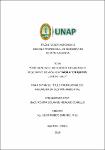| dc.contributor.advisor | Pinedo Jiménez, Julio | |
| dc.contributor.author | Hidalgo Cuhello, Rosita Solange | |
| dc.date.accessioned | 2019-07-17T17:33:42Z | |
| dc.date.available | 2019-07-17T17:33:42Z | |
| dc.date.issued | 2019 | |
| dc.identifier.uri | http://repositorio.unapiquitos.edu.pe/handle/20.500.12737/6254 | |
| dc.description.abstract | La investigación tuvo como objetivo evaluar si las frecuencias de riego influyen en el comportamiento del desarrollo vegetativo de la sábila, cultivado en condiciones de clima de la región Loreto.
El ensayo corresponde al diseño investigación de experimento verdadero, porque cumple con la asignación aleatoria (grupo control) e intervención, por la planificación de la toma de datos, el número de ocasiones en que se mide la variable en estudio y el número de variables de interés. El tipo de investigación se clasifica como: Experimental, prospectivo, transversal, analítico y de nivel investigativo “explicativo” (causa – efecto). El diseño estadístico de la investigación es el Diseño Irrestrictamente al Azar (DIA), con 20 replicaciones.
De acuerdo a los resultados obtenidos en relación a las características de crecimiento que mejor se comportan son cuando la planta de sábila recibe agua de riego cada dieciséis; sin embargo las plantas podrían soportar a días más prolongadas de riego, criadas en macetas bajo cubiertas que reciban luz directa más de 09 horas al día en condiciones climatológicas de la región Loreto.
En relación a las características de rendimiento, los resultados nos permiten deducir que las plantas de sábilas al ser cultivadas en espacios libres sometidas a las inclemencias del tiempo pueden desarrollarse de forma productiva en épocas con frecuencias de lluvias quincenal, incluso podrían soportar tiempos más prolongados de lluvias siempre que la maceta contenga un sustrato con buena retención de humedad, de buena porosidad y de un tamaño adecuado.
Finalmente concluimos que el comportamiento del cultivo de la sábila con diferentes frecuencias de riego fueron muy similares, hay ahorro de agua en frecuencia de riego cada 16 días. | es_PE |
| dc.description.abstract | The objective of the investigation was to evaluate if irrigation frequencies influence the behavior of the vegetative development of aloe, cultivated under climate conditions of the Loreto region.
The test corresponds to the true experiment research design, because it complies with the random assignment (control group) and intervention, for the planning of the data collection, the number of occasions in which the variable under study is measured and the number of variables of interest. The type of research is classified as: Experimental, prospective, transversal, analytical and "explanatory" investigative level (cause - effect). The statistical design of the research is Irresistibly Random Design (DIA), with 20 replications.
According to the results obtained in relation to the growth characteristics that best behave are when the plant of aloe receives irrigation water every sixteen; however, the plants could withstand longer days of irrigation, grown in pots under covers that receive direct light more than 09 hours a day in the Loreto region.
In relation to the performance characteristics, the results allow us to deduce that the plants of aloes when being cultivated in free spaces subjected to the inclemency of the time can develop of productive form in times with frequencies of fortnightly rains, they could even support longer times of rains provided that the pot contains a substrate with good moisture retention, good porosity and an adequate size.
Finally we concluded that the behavior of the cultivation of the aloe with different irrigation frequencies were very similar, there is water saving in irrigation frequency every 16 days. | es_PE |
| dc.description.uri | Tesis | es_PE |
| dc.format | application/pdf | es_PE |
| dc.language.iso | spa | es_PE |
| dc.publisher | Universidad Nacional de la Amazonía Peruana | es_PE |
| dc.rights | info:eu-repo/semantics/openAccess | es_PE |
| dc.rights | Attribution-NonCommercial-NoDerivs 3.0 United States | * |
| dc.rights.uri | http://creativecommons.org/licenses/by-nc-nd/3.0/us/ | * |
| dc.source | Universidad Nacional de la Amazonía Peruana | es_PE |
| dc.source | Repositorio institucional - UNAP | es_PE |
| dc.subject | Frecuencia de riego | es_PE |
| dc.subject | Sábila | es_PE |
| dc.subject | Aloe vera | es_PE |
| dc.subject | Desarrollo de la planta | es_PE |
| dc.title | Frecuencia de riego en el desarrollo vegetativo de Aloe vera "sábila" en Iquitos. Loreto - 2017 | es_PE |
| dc.type | info:eu-repo/semantics/bachelorThesis | es_PE |
| thesis.degree.discipline | Ingeniería en Gestión Ambiental | es_PE |
| thesis.degree.grantor | Universidad Nacional de la Amazonía Peruana. Facultad de Agronomía | es_PE |
| thesis.degree.level | Título Profesional | es_PE |
| thesis.degree.name | Ingeniero(a) en Gestión Ambiental | es_PE |
| thesis.degree.program | Presencial | es_PE |
| dc.subject.ocde | Agricultura | es_PE |
| dc.subject.ocde | http://purl.org/pe-repo/ocde/ford#4.01.01 | es_PE |


